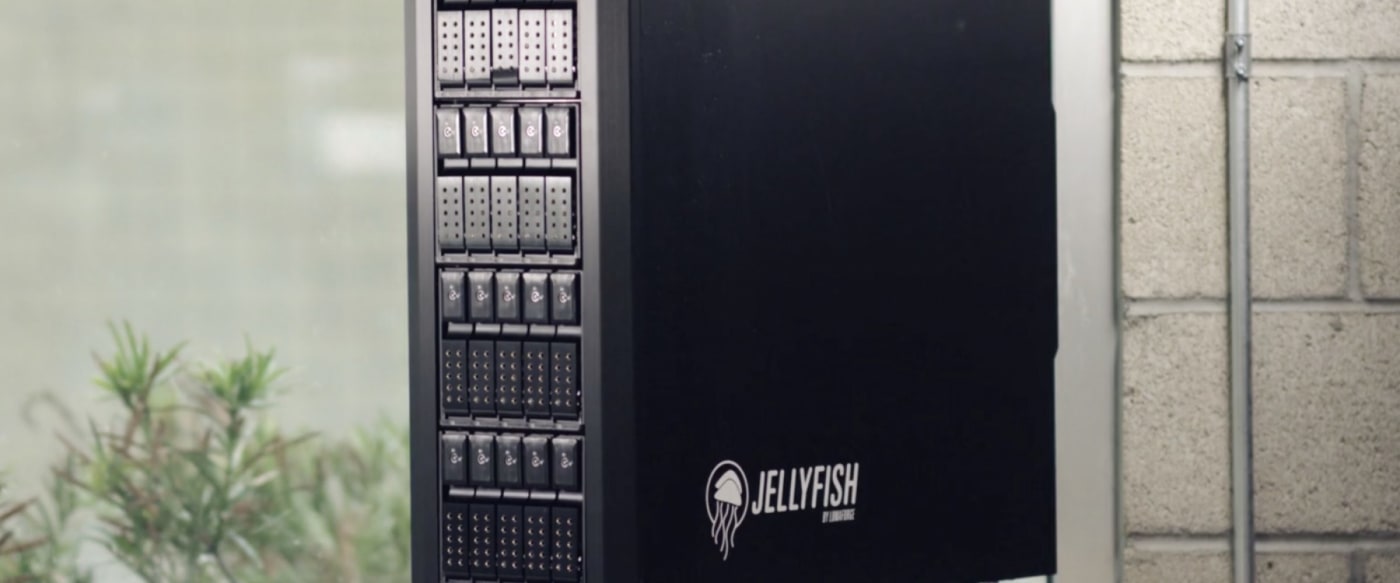
The Jellyfish is a video workflow server designed for small, medium and large-sized teams that need to work off of the same footage at the same time, whether it's for one project or many. The Jellyfish comes in three different flavors, first of which is the Jellyfish Mobile. It's great for connecting up to 14 people directly for editing in HD or up to six people if you're wanting to edit in 4K. It also comes with a great little handle on top so that if you want to take it with you on set or with you to a live event, you absolutely can.
Next is the Jellyfish Tower, which is whisper-quiet, can sit next to you in the room if necessary, and it allows you to connect up to 20 people directly off of the same Jellyfish for working in 4K, HD or any number of other resolutions.
The Jellyfish Rack is unique in that it actually fits in a server rack. Other than that, it's very, very similar to the Jellyfish Tower. It's still quiet and can connect up to 20 people directly without any need for a switch.
How much do they cost?
Regarding price, the Jellyfish Mobile starts at about $9,500 for 32 terabytes raw, which is about 23 terabytes usable. Whereas, the Jellyfish Tower and Rack start at about $30,000 for 80 terabytes raw or 53 terabytes usable. Now the reason that there are less usable terabytes than the overall raw is that we have redundancy built into each of these systems. With the Jellyfish Mobile, you can lose either one or two drives without losing any data. It's up to you and how you want it configured. The Jellyfish Tower and Rack, on the other hand, you can lose up to four drives without losing any data whatsoever.
How fast are they?
In terms of speed, the Jellyfish Mobile has about 2,300 megabytes per second aggregate read speed, which means you have 2,300 megabytes per second divided across your users. For the Jellyfish Tower and Jellyfish Rack, you have about 4,400 megabytes per second aggregate speed. On any of these models, if you decide that you're going to expand your system and you expand by the same amount as your head unit, then you can actually increase your overall speeds.
How do I connect my computer? Do I need a switch?
In terms of connections, the best-case scenario is to connect your Jellyfish Mobile, Tower or Rack directly to your computer. If you've got something like an iMac Pro, a Mac mini or certain PCs, you'll have a 10G Ethernet connection on that machine, which will allow you to connect and edit at 4K right out of the box. Now, if you don't have 10G connections on your machine but you still want to edit in 4K, Sonnet and AKiTio make adapters that will allow you to go from 10G Ethernet, which comes from the Jellyfish to Thunderbolt.
In a situation where you're wanting to either use a render farm or Resolve collaboration where you need to have people on the same network, or maybe you need more than 20 people connected to the Jellyfish, you might need to have a switch. Because it can get a little complicated setting up a switch, LumaForge is proud to announce that we have an integration team that makes it super easy to make your workflow work for you.
How can I learn more?
The best way to learn more about a Jellyfish is to connect with our sales team, or build one yourself! We also have a ton of great content on Youtube channel where you can learn workflow tips and more!
Other topics you might like
LumaForge is now an OWC company!
Updated on Jan 14, 2021
What is Jellyfish Media Engine?
Updated on Dec 15, 2020
Kyno for Jellyfish - Better than Finder
Updated on Dec 15, 2020
Save time and money by future-proofing your video editing workflow
Updated on Dec 10, 2020
Is Final Cut Pro X for Hollywood?
Updated on Oct 27, 2020
Meet Your New Pre-Editing Process
Updated on Oct 19, 2020
Video Workflow: A Quickstart Guide
Updated on Oct 13, 2020
Video Marketing 101
Updated on Oct 7, 2020
Video in Education
Updated on Sep 29, 2020








